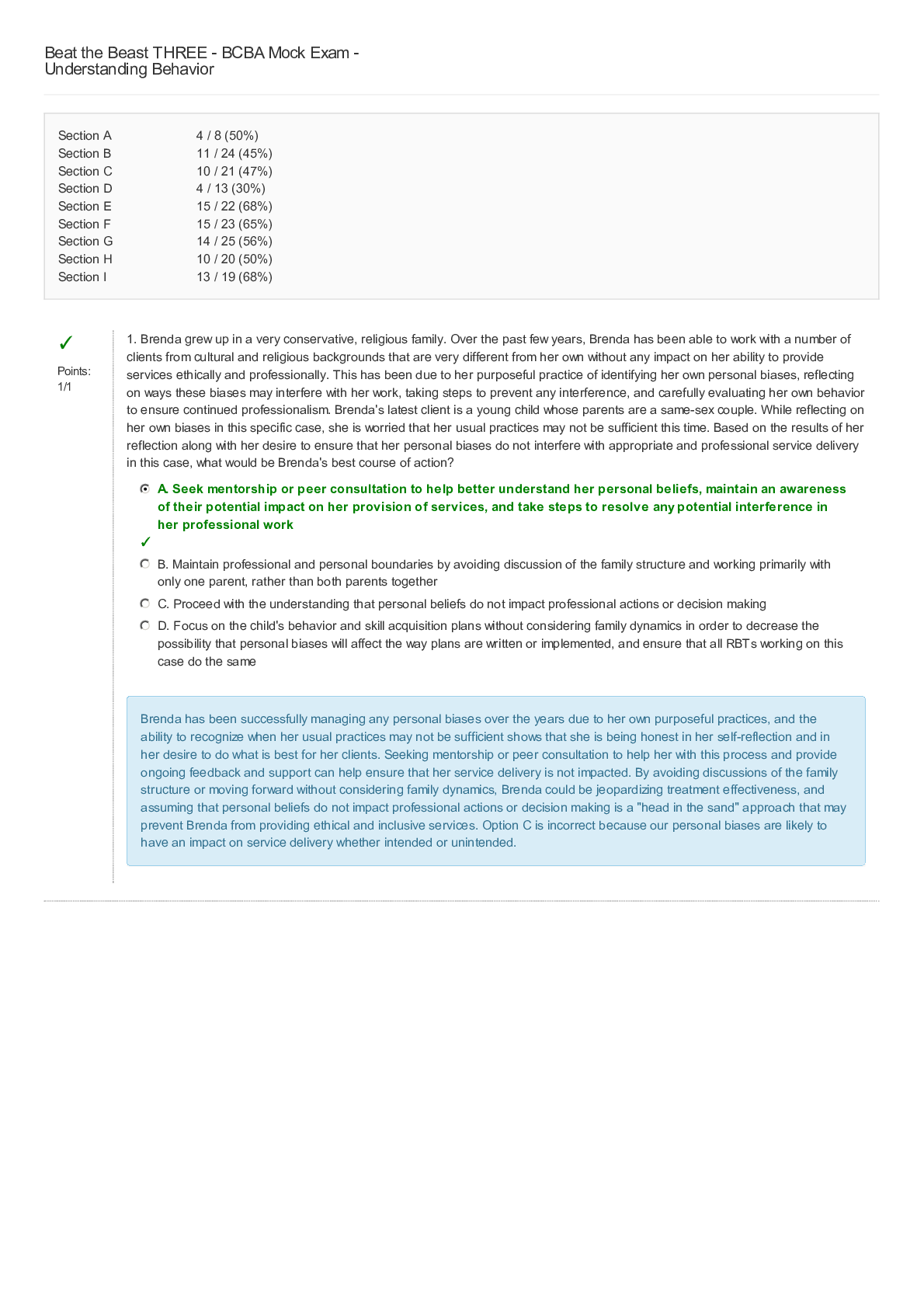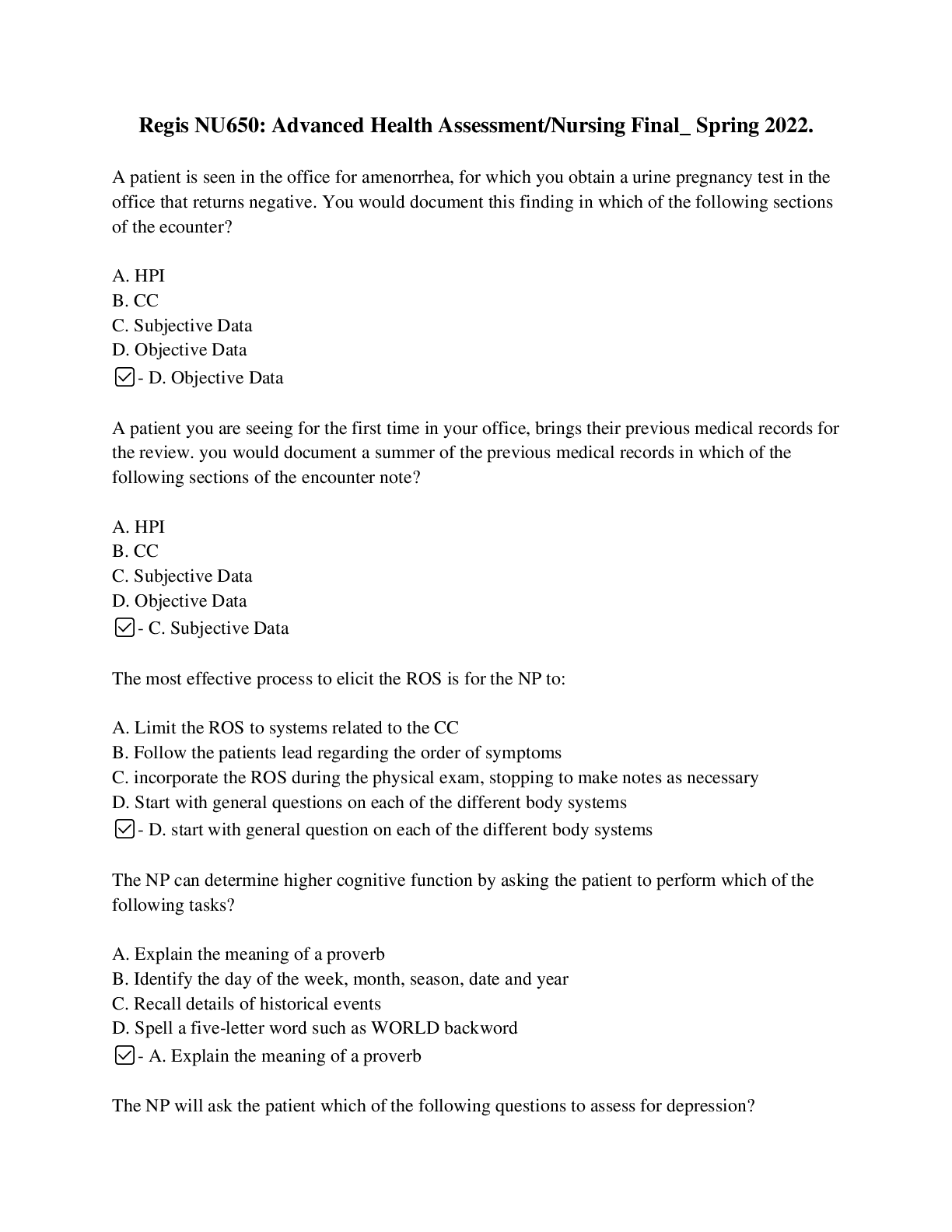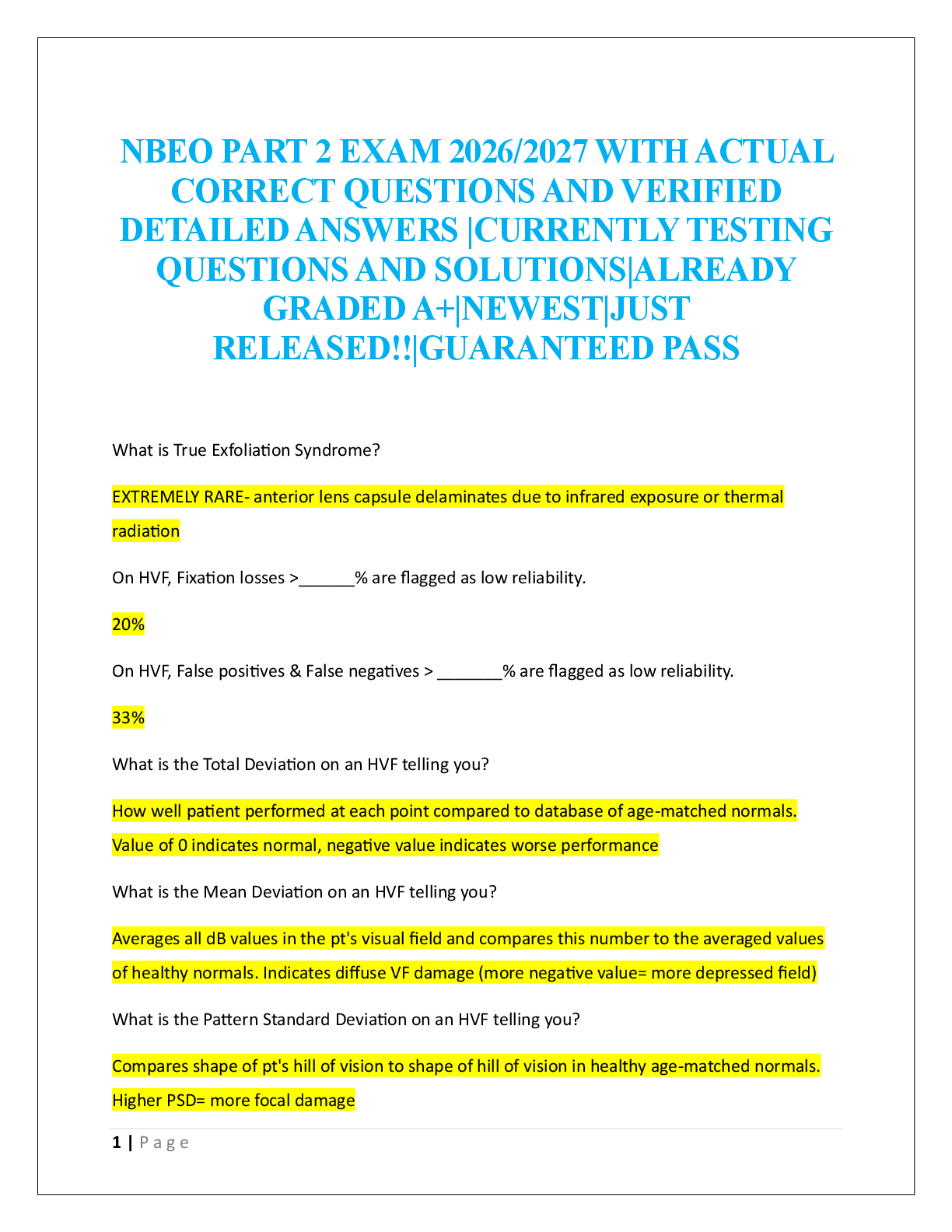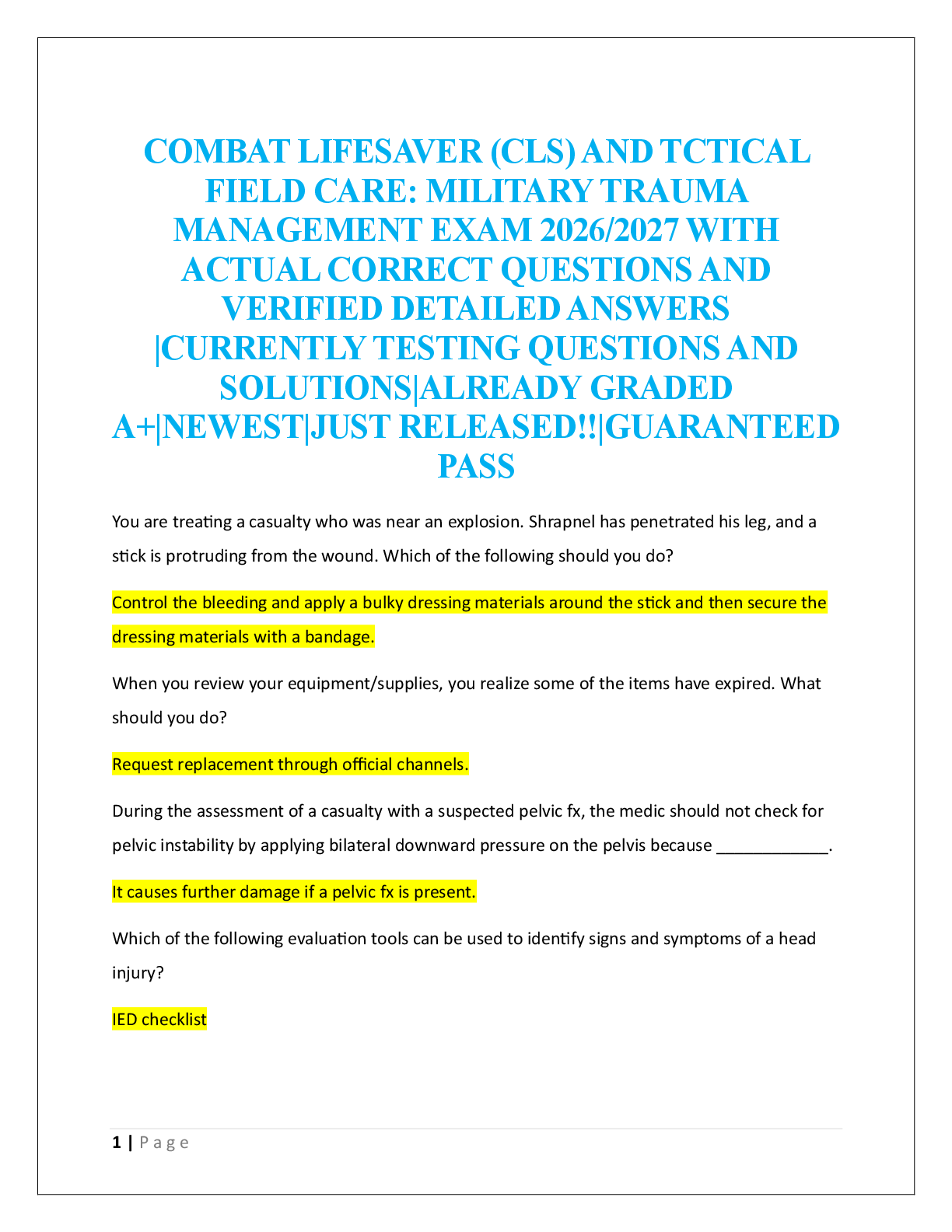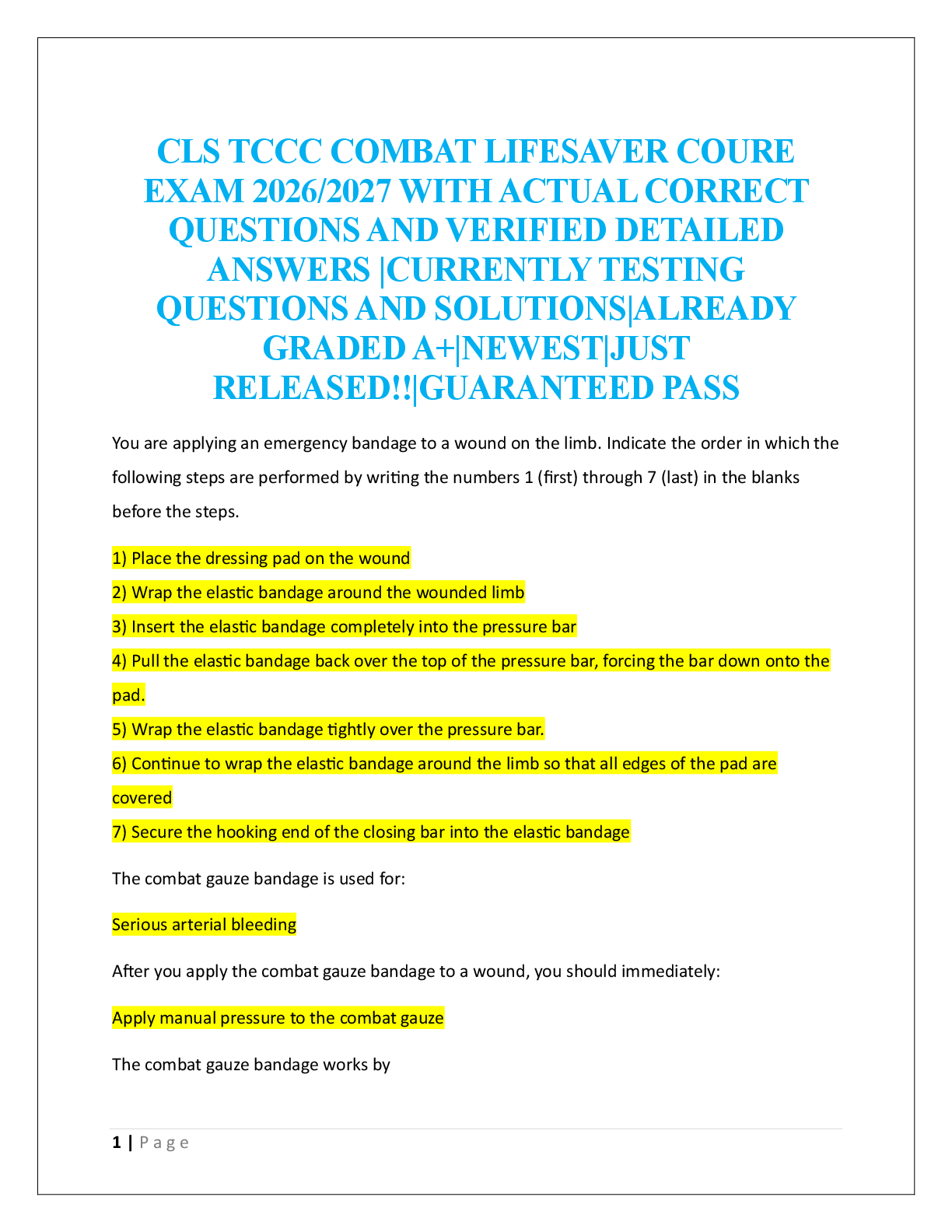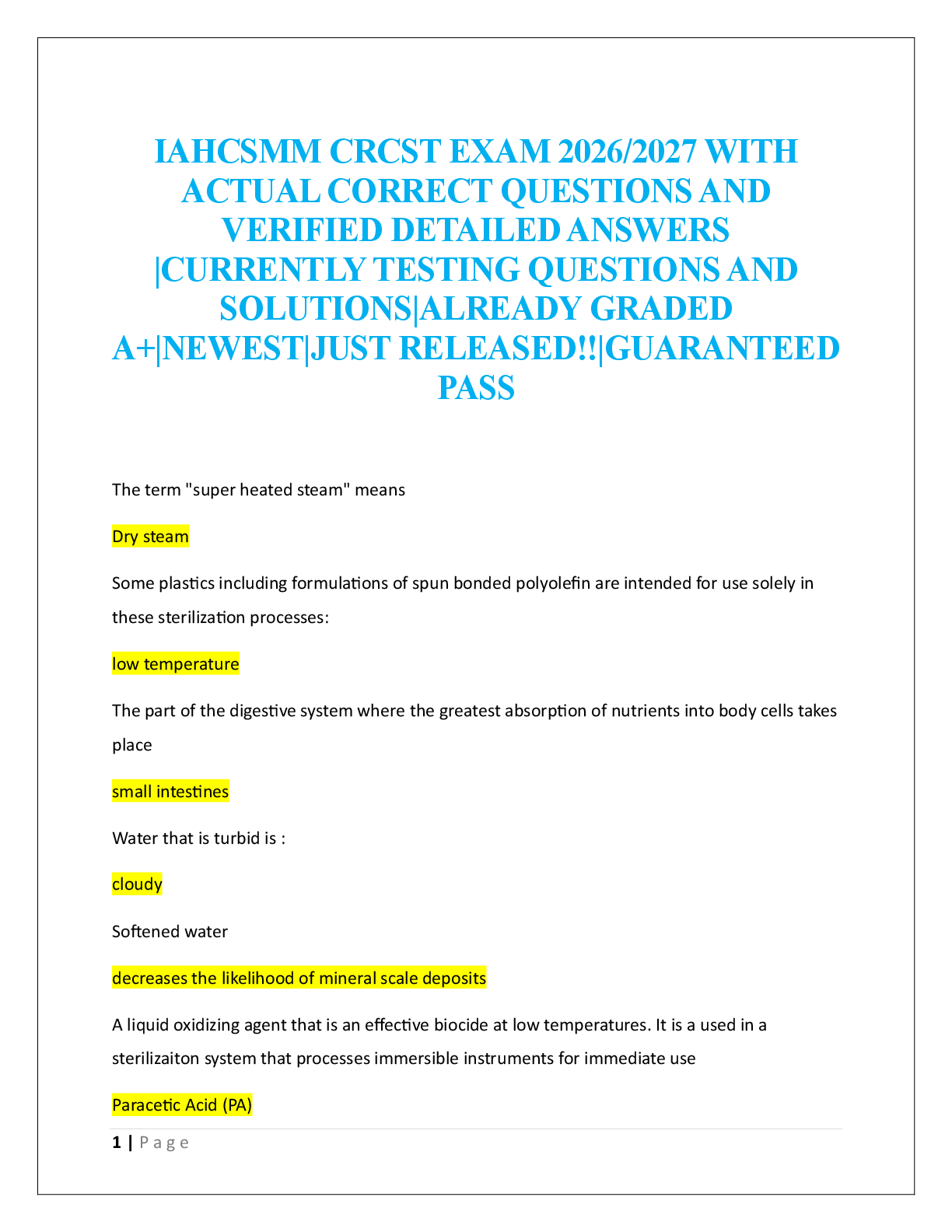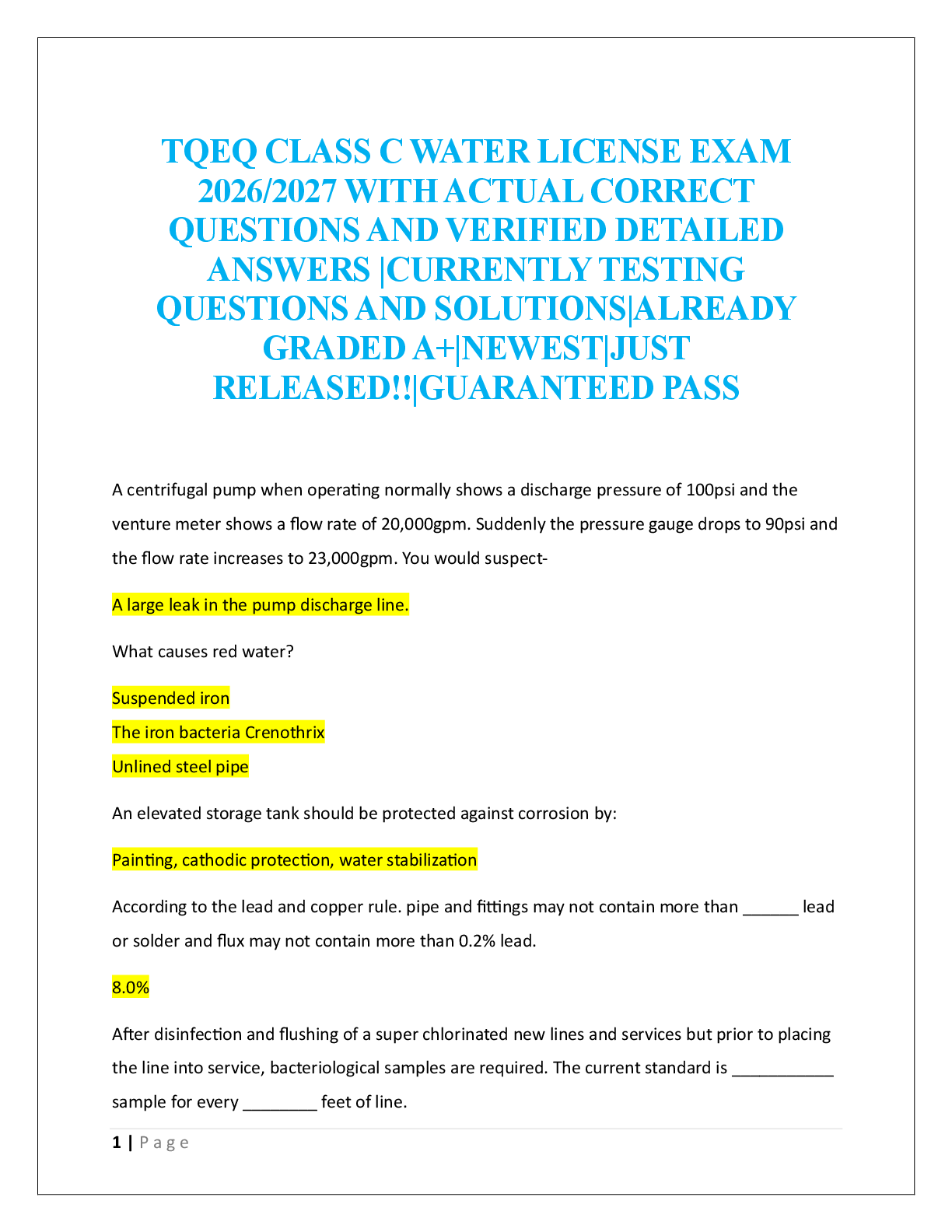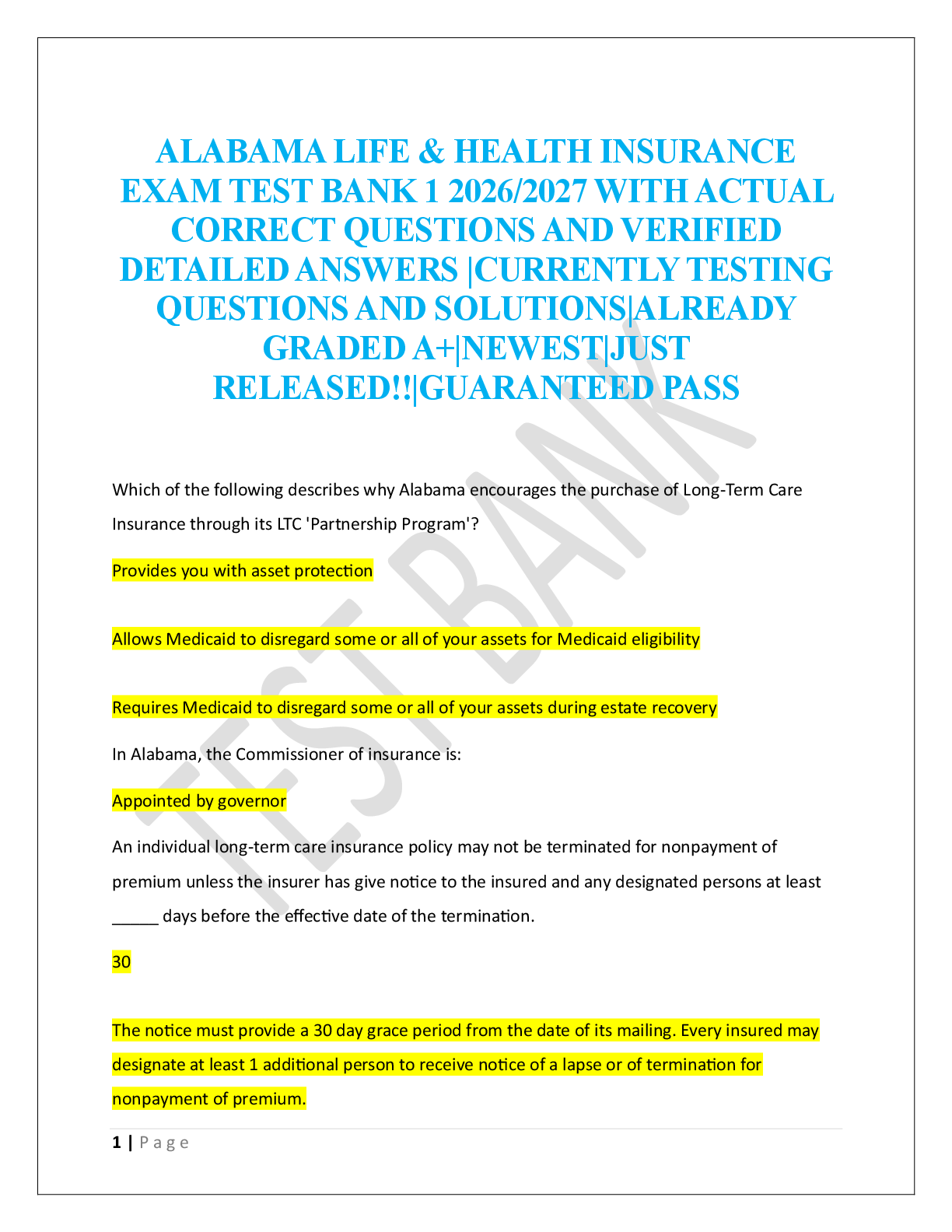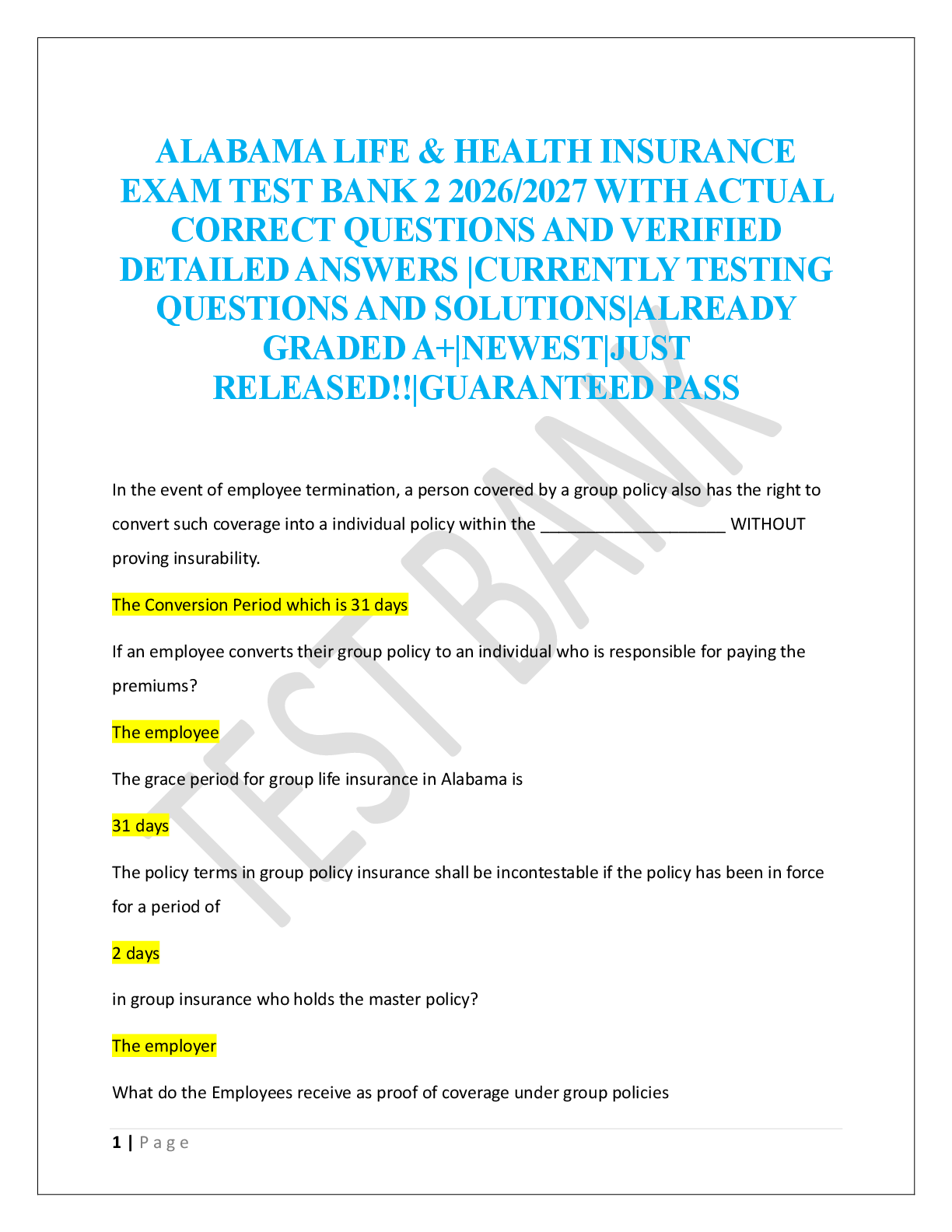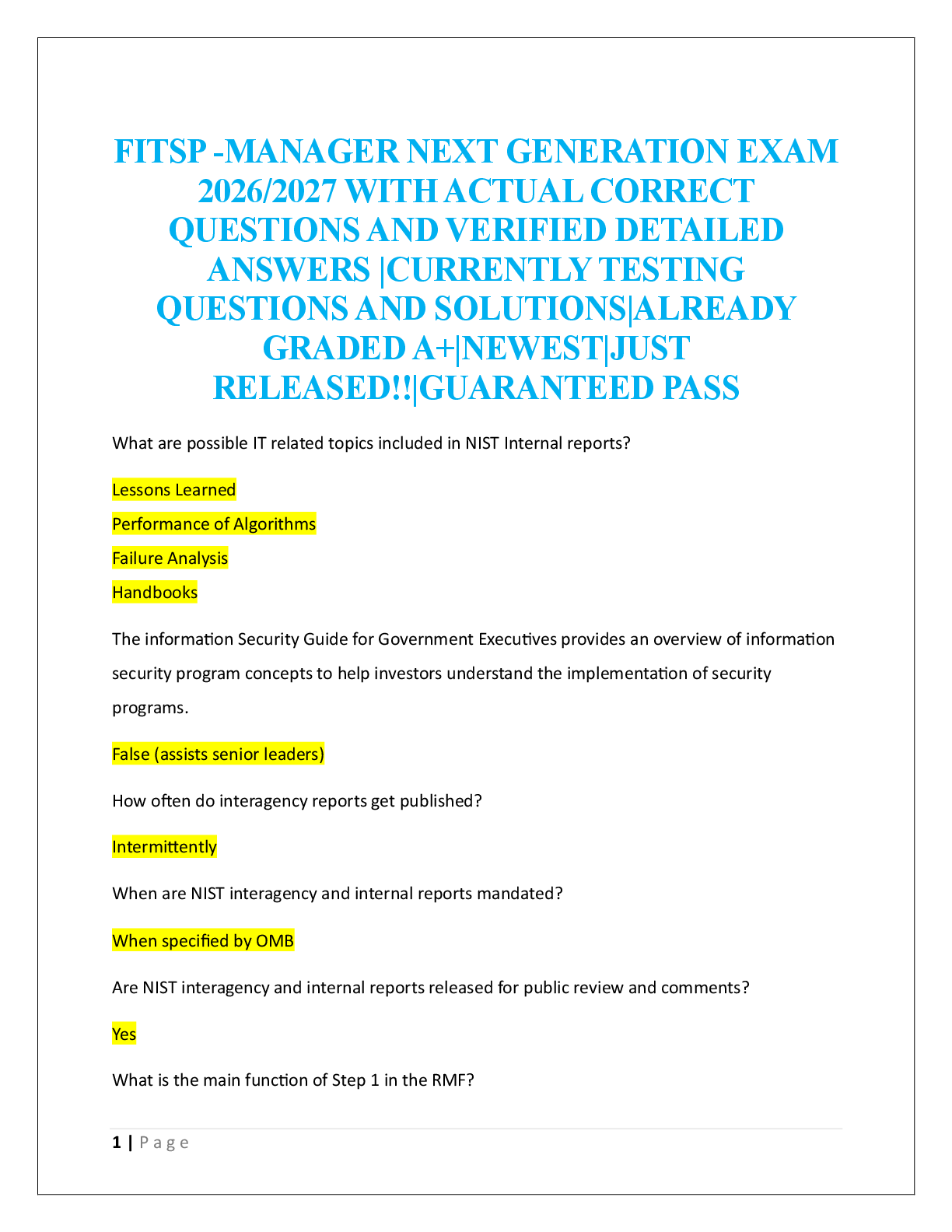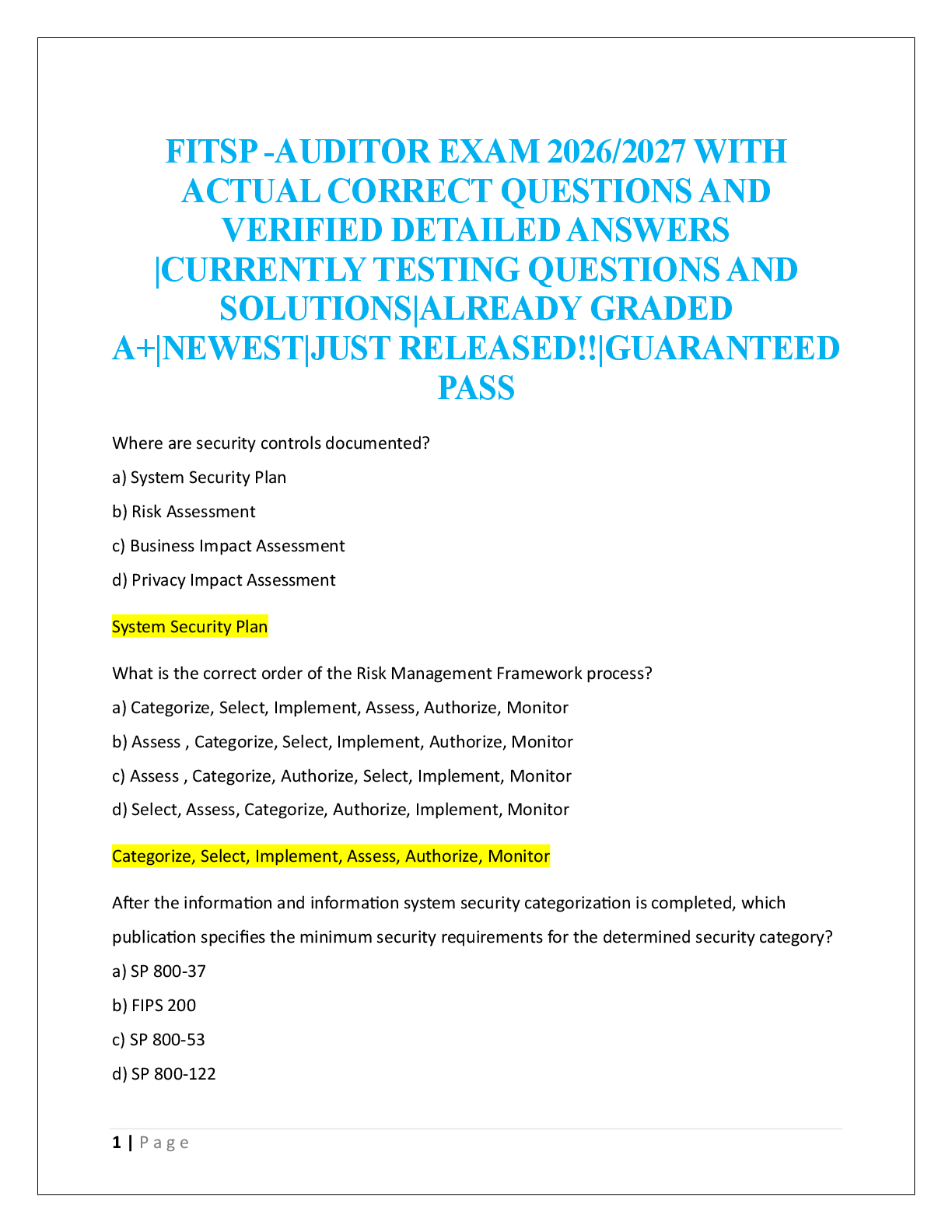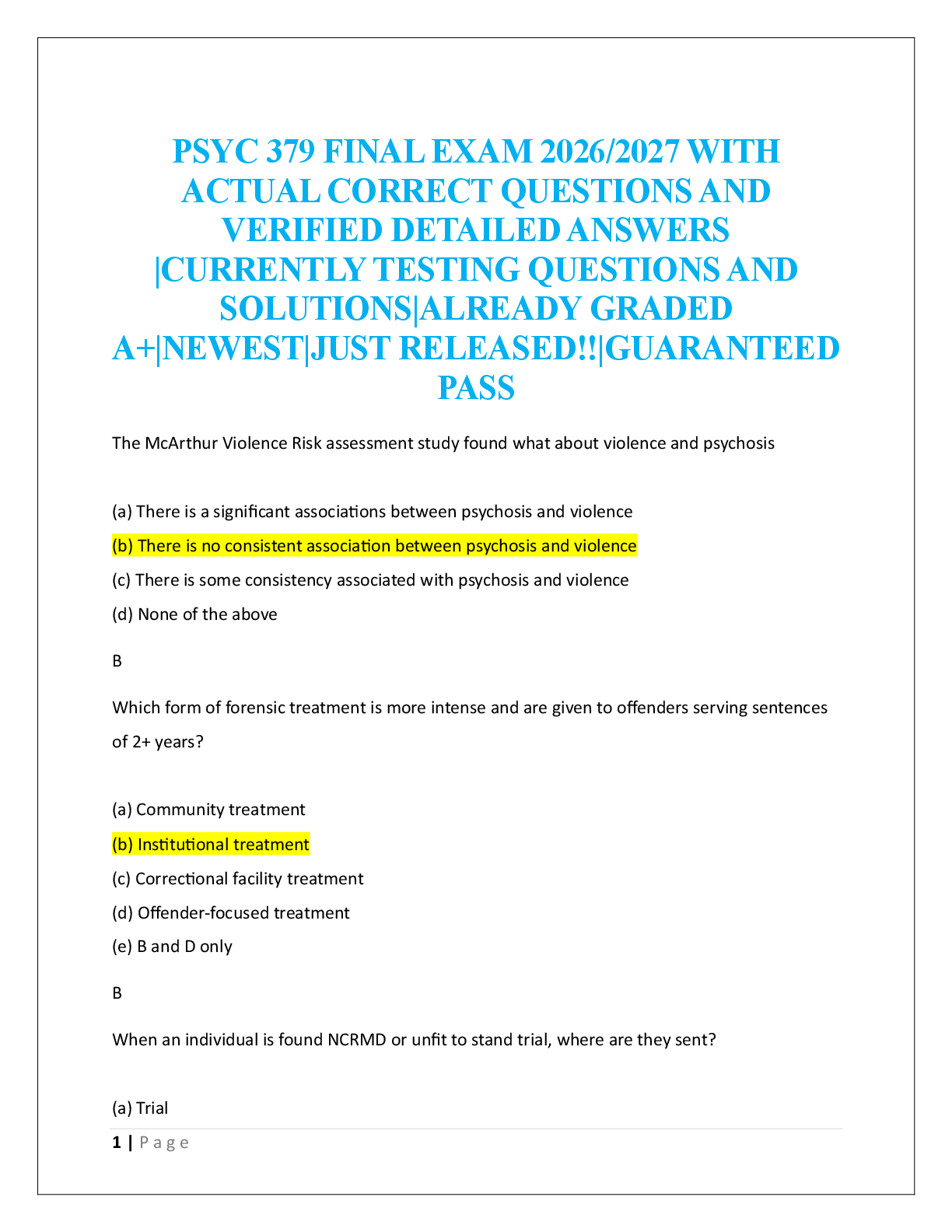*NURSING > EXAM > NR 509 : Advanced physical assessment quiz 4, Latest (2019/20) Complete Solutions with Explanations. (All)
NR 509 : Advanced physical assessment quiz 4, Latest (2019/20) Complete Solutions with Explanations.
Document Content and Description Below
NR 509 Advanced physical assessment quiz 4 1. Question : During an examination, the patient states he is hearing a buzzing sound and says that it is “driving me crazy!” The nurse recognizes t ... hat this symptom indicates vertigo. pruritus. tinnitus. cholesteatoma. Question 2. Question : A patient has been shown to have a sensorineural hearing loss. During the assessment, it would be important for the nurse to speak loudly so he can hear the questions. assess for middle ear infection as a possible cause. ask the patient what medications he is currently taking. look for the source of the obstruction in the external ear. Question 3. Question : The nurse is explaining to a patient that there are “shock absorbers” in his back to cushion the spine and to help it move. The nurse is referring to his vertebral column. nucleus pulposus. vertebral foramen. intervertebral disks. Question 4. Question : The nurse educator is preparing an education module for the nursing staff on the epidermal layer of skin. Which of these statements would be included in the module? The epidermis is highly vascular. thick and tough. thin and nonstratified. replaced every 4 weeks. Question 5. Question : The nurse is examining a 6-month-old infant and places the infant’s feet flat on the table and flexes his knees up. The nurse notes that the right knee is significantly lower than the left. Which of these statements is true of this finding? This is a positive Allis sign and suggests hip dislocation. The infant probably has a dislocated patella on the right. This is a normal finding for the Allis test for an infant of this age. The infant should return to the clinic in 2 weeks to see if this has changed. Question 6. Question : A patient drifts off to sleep when she is not being stimulated. The nurse can arouse her easily when calling her name, but she remains drowsy during the conversation. The best description of this patient’s level of consciousness would be lethargic. obtunded. stuporous. semialert. Question 7. Question : A 65-year-old man is brought to the emergency department after he was found dazed and incoherent, alone in his apartment. He has an enlarged liver and is moderately dehydrated. When evaluating his serum albumin level, the nurse must keep in mind that serum albumin levels will increase as liver function decreases. serum albumin levels are a sensitive measure of early protein malnutrition. low serum albumin levels may be caused by reasons other than protein-calorie malnutrition. the results of the serum albumin measurement along with the patient’s hemoglobin level should be considered. Question 8. Question : The nurse is checking the range of motion in a patient’s knee and knows that the knee is capable of which movement(s)? Flexion and extension Supination and pronation Circumduction Inversion and eversion Question 9. Question : A patient has been admitted after an accident at work. During the assessment, the patient is having trouble hearing and states, “I don’t know what the matter is. All of a sudden, I can’t hear you out of my left ear!” What should the nurse do next? Make note of this finding for report to the next shift. Prepare to remove cerumen from the patient’s ear. Notify the patient’s healthcare provider. Irrigate the ear with rubbing alcohol. Question 10. Question : A 40-year-old man has come into the clinic with complaints of “extreme tenderness in my toes.” The nurse notices that his toes are slightly swollen, reddened, and warm to the touch. His complaints would suggest osteoporosis. acute gout. ankylosing spondylitis. degenerative joint disease. Question 11. Question : A 19-year-old college student is brought to the emergency department with a severe headache he describes as “like nothing I’ve ever had before.” His temperature is 104° F, and he has a stiff neck. The nurse looks for other signs and symptoms of which problem? Head injury Cluster headache Migraine headache Meningeal inflammation Question 12. Question : A mother brings her newborn baby boy in for a checkup; she tells the nurse that he doesn’t seem to be moving his right arm as much as his left and that he seems to have pain when she lifts him up under the arms. The nurse suspects a fractured clavicle and would observe for a negative Allis test. a positive Ortolani’s sign. limited range of motion during the Moro’s reflex. limited range of motion during Lasègue’s test Question 13. Question : While performing the otoscopic examination of a 3-year-old boy who has been pulling on his left ear, the nurse finds that his left tympanic membrane is bright red and that the light reflex is not visible. The nurse interprets these findings to indicate a fungal infection. acute otitis media. perforation of the ear drum. cholesteatoma. Question 14. Question : The nurse is teaching a class on osteoporosis prevention to a group of postmenopausal women. Which of these actions is the best way to prevent or delay bone loss in this group? Taking calcium and vitamin D supplements Taking medications to prevent osteoporosis Performing physical activity, such as fast walking Assessing bone density annually Question 15. Question : The nurse is examining a 2-year-old child and asks, “May I listen to your heart now?” Which critique of the nurse’s technique is most accurate? Asking questions enhances the child’s autonomy. Asking the child for permission helps to develop a sense of trust. This is an appropriate statement because children at this age like to have choices. Children at this age like to say “no.” The examiner should not offer a choice when there is none. Question 16. Question : Which of these assessment findings would the nurse expect to see when examining the eyes of a black patient? Increased night vision A dark retinal background Increased photosensitivity Narrowed palpebral fissures Question 17. Question : A 50-year-old patient has been brought to the emergency department after a housemate found that he could not get out of bed alone. He has lived in a group home for years, but for several months he has not participated in the activities and has stayed in his room. The nurse assesses for signs of undernutrition, and x-rays reveal that he has osteomalacia, which is a deficiency of iron. riboflavin. vitamin D and calcium. vitamin C. Question 18. Question : A patient who has had rheumatoid arthritis for years comes to the clinic to ask about changes in her fingers. The nurse will assess for signs of what problems? Heberden’s nodes Bouchard’s nodules Swan neck deformities Dupuytren’s contractures Question 19. Question : The nurse notices that a patient has a solid, elevated, circumscribed lesion that is less than 1 cm in diameter. When documenting this finding, the nurse would report this as a bulla. wheal. nodule. papule. Question 20. Question : Just before going home, a new mother asks the nurse about the infant’s umbilical cord. Which of these statements is correct? “It should fall off by 10 to 14 days.” “It will soften before it falls off.” “It contains two veins and one artery.” “Skin will cover the area within 1 week.” Question 21. Question : The nurse is assessing a patient with a history of intravenous drug abuse. In assessing his mouth, the nurse notices a dark red confluent macule on the hard palate. This could be an early sign of AIDS. measles. leukemia. carcinoma. Question 22. Question : When observing a patient’s verbal and nonverbal communication, the nurse notices a discrepancy. Which statement is true regarding this situation? The nurse should ask someone who knows the patient well to help interpret this discrepancy. focus on the patient’s verbal message and try to ignore the nonverbal behaviors. try to integrate the verbal and nonverbal messages and then interpret them as an “average.” focus on the patient’s nonverbal behaviors because these are often more reflective of a patient’s true feelings. Question 23. Question : The nurse is assessing a 75-year-old man. As the nurse begins the mental status portion of the assessment, the nurse expects that this patient will have no decrease in any of his abilities, including response time. will have difficulty on tests of remote memory because this typically decreases with age. may take a little longer to respond, but his general knowledge and abilities should not have declined. will have had a decrease in his response time because of language loss and a decrease in general knowledge. Question 24. Question : When reviewing the demographics of ethnic groups in the United States, the nurse recalls that the largest and fasting growing population is Hispanic. Black. Asian. American Indian. Question 25. Question : During an examination, the nurse asks a patient to bend forward from the waist and notices that the patient has lateral tilting. When his leg is raised straight up, he complains of a pain going down his buttock into his leg. The nurse suspects scoliosis. meniscus tear. herniated nucleus pulposus. spasm of paravertebral muscles. Question 26. Question : During an examination of a 3-year-old child, the nurse will need to take her blood pressure. What might the nurse do to try to gain the child’s full cooperation? Tell the child that the blood pressure cuff is going to give her arm a big hug. Tell the child that the blood pressure cuff is asleep and cannot wake up. Give the blood pressure cuff a name and refer to it by this name during the assessment. Tell the child that by using the blood pressure cuff, we can see how strong her muscles are. Question 27. Question : Which of these statements is true regarding the use of standard precautions in the healthcare setting? Standard precautions apply to all body fluids, including sweat. Use alcohol-based hand rub if hands are visibly dirty. Standard precautions are intended for use with all patients regardless of their risk or presumed infection status. Standard precautions are to be used only when there is nonintact skin, excretions containing visible blood, or expected contact with mucous membranes. Question 28. Question : Which term refers to a wound produced by the tearing or splitting of body tissue, usually from blunt impact over a bony surface? Abrasion Contusion Laceration Hematoma Question 29. Question : A 70-year-old man has a blood pressure of 150/90 mm Hg in a lying position, 130/80 mm Hg in a sitting position, and 100/60 mm Hg in a standing position. How should the nurse evaluate these findings? This is a normal response due to changes in the patient’s position. The change in blood pressure readings is called orthostatic hypotension. The blood pressure reading in the lying position is within normal limits. The change in blood pressure reading is considered within normal limits for the patient’s age. Question 30. Question : A patient with a middle ear infection asks the nurse, “What does the middle ear do?” The nurse responds by telling the patient that the middle ear functions to maintain balance. interpret sounds as they enter the ear. conduct vibrations of sounds to the inner ear. increase amplitude of sound for the inner ear to function. Question 31. Question : Which statement is best for the nurse to use when preparing to administer the Abuse Assessment Screen? “We are required by law to ask these questions.” “We need to talk about whether you feel you have been abused.” “We are asking these questions because we suspect that you are being abused.” “We ask the following questions because domestic violence is so common in our society.” Question 32. Question : A professional tennis player comes into the clinic complaining of a sore elbow. The nurse will assess for tenderness at the olecranon bursa. annular ligament. base of the radius. medial and lateral epicondyle. Question 33. Question : The nurse is assessing the mental status of a child. Which of these statements about children and mental status is true? All aspects of mental status in children are interdependent. Children are highly labile and unstable until the age of 2 years. Children’s mental status is largely a function of their parents’ level of functioning until the age of 7 years. A child’s mental status is impossible to assess until the child develops the ability to concentrate. Question 34. Question : A 19-year-old woman comes to the clinic at the insistence of her brother. She is wearing black combat boots and a black lace nightgown over the top of her other clothes. Her hair is dyed pink with black streaks throughout. She has several pierced holes in her nares and ears and is wearing an earring through her eyebrow and heavy black makeup. The nurse concludes she probably doesn’t have any problems at all. she is just trying to shock people and her dress should be ignored. she has manic syndrome because of her abnormal dress and grooming. that more information should be gathered to decide whether her dress is appropriate. Question 35. Question : A patient is visiting the clinic for an evaluation of a swollen, painful knuckle. The nurse notices that the knuckle above his ring on the left hand is swollen and that he is unable to remove his wedding ring. This joint is called the _____ joint. interphalangeal tarsometatarsal metacarpophalangeal tibiotalar Question 36. Question : A 52-year-old patient describes the presence of occasional “floaters” or “spots” moving in front of his eyes. The nurse should examine the retina to determine the number of floaters. presume the patient has glaucoma and refer him for further testing. consider this an abnormal finding and refer him to an ophthalmologist. know that floaters are usually not significant and are caused by condensed vitreous fibers. Question 37. Question : A mother brings in her newborn infant for an assessment and tells the nurse that she has noticed that whenever her newborn’s head is turned to the right side, she straightens out the arm and leg on the same side and flexes the opposite arm and leg. After finding this on examination, the nurse would tell her that this is abnormal and is called the atonic neck reflex. normal and should disappear by the first year of life. normal and should disappear between 3 and 4 months of age. abnormal. The baby should be flexing the arm and leg on the right side of his body when the head is turned to the right. Question 38. Question : A patient comes to the clinic complaining of neck and shoulder pain and is unable to turn her head. The nurse suspects damage to cranial nerve (CN) _____ and proceeds with the examination by _____. XI; palpating the anterior and posterior triangles XI; asking the patient to shrug her shoulders against resistance XII; percussing the sternomastoid and submandibular neck muscles XII; assessing for a positive Romberg sign Question 39. Question : The nurse is testing a patient’s visual accommodation, which refers to which action? Pupillary constriction when looking at a near object Pupillary dilation when looking at a far object Changes in peripheral vision in response to light Involuntary blinking in the presence of bright light Question 40. Question : The nurse is assessing the skin of a patient who has AIDS and notices multiple patch-like lesions on the temple and beard area that are faint pink in color. The nurse recognizes these lesions as measles (rubeola). Kaposi’s sarcoma. angiomas. herpes zoster. Question 41. Question : The nurse is assessing the vital signs of a 20-year-old male marathon runner and documents the following vital signs: temperature—97 F; pulse—48 beats per minute; respirations—14 per minute; blood pressure—104/68 mm Hg. Which statement is true about these results? The patient is experiencing tachycardia. These are normal vital signs for a healthy, athletic adult. The patient’s pulse rate is not normal—his physician should be notified. On the basis of today’s readings, the patient should return to the clinic in 1 week. Question 42. Question : The nurse is planning health teaching for a 65-year-old woman who has had a cerebrovascular accident, or stroke, and is aphasic. Which of these questions is most important to use when assessing mental status in this situation? “Please count back from 100 by seven.” “I will name three items and ask you to repeat them in a few minutes.” “Please point to articles in the room and parts of the body as I name them.” “What would you do if you found a stamped, addressed envelope on the sidewalk?” Question 43. Question : The nurse is unable to identify any changes in sound when percussing over the abdomen of an obese patient. What should the nurse do next? Ask the patient to take deep breaths to relax the abdominal musculature. Consider this a normal finding and proceed with the abdominal assessment. Increase the amount of strength used when attempting to percuss over the abdomen. Decrease the amount of strength used when attempting to percuss over the abdomen. Question 44. Question : A 35-year-old pregnant woman comes to the clinic for a monthly appointment. During the assessment, the nurse notices that she has a brown patch of hyperpigmentation on her face. The nurse continues the skin assessment aware that another finding may be keratoses. xerosis. chloasma acrochordons. Question 45. Question : During a session on substance abuse, the nurse is reviewing statistics with the class. For persons aged 12 years and older, which of these illicit substances was the one most commonly used? Crack cocaine Heroin Marijuana Hallucinogens Question 46. Question : A 92-year-old patient has had a stroke. The right side of his face is drooping. The nurse might also suspect which of these assessment findings? Epistaxis Rhinorrhea Dysphagia Xerostomia Question 47. Question : The nurse is assessing the body weight as a percentage of ideal body weight on an adolescent patient who was admitted for suspected anorexia nervosa. The patient’s usual weight was 125 pounds, but today she weighs 98 pounds. The nurse calculates the patient’s ideal body weight, and reaches which conclusion? She is experiencing mild malnutrition. She is experiencing moderate malnutrition. She is experiencing severe malnutrition. Her current weight is still within expected parameters. Question 48. Question : The nurse knows that one advantage of the tympanic thermometer is that its rapid measurement is useful for uncooperative younger children. it is the most accurate method for measuring temperature in newborn infants. it is an inexpensive means of measuring temperature. studies strongly support use of the tympanic route in children under age 6 years. Question 49. Question : The nurse recognizes that an example of a person who is heritage-consistent would be a woman who has adapted her clothing to the clothing style of her new country. woman who follows the traditions that her mother followed regarding meals. man who is not sure of his ancestor’s country of origin. child who is not able to speak his parents’ native language. Question 50. Question : During an assessment of an infant, the nurse notes that the fontanels are depressed and sunken. The nurse suspects which condition? Rickets Dehydration Mental retardation Increased intracranial pressure Question 51. Question : When considering a nutritional assessment, the nurse is aware that the most common anthropometric measurements include height and weight. leg circumference. biceps skinfold thickness. hip and waist measurement. Question 52. Question : The nurse is providing nutrition information to the mother of a 1-year-old child. Which of these statements represents accurate information for this age group? It is important to maintain adequate fat and caloric intake. The recommended dietary allowances for an infant are the same as for an adolescent. At this age, the baby’s growth is minimal so caloric requirements are decreased. The baby should be placed on skim milk to decrease the risk of coronary artery disease when older. Question 53. Question : The nurse needs to palpate the temporomandibular joint for crepitation. This joint is located just below the temporal artery and anterior to the hyoid. vagus nerve. tragus. mandible. Question 54. Question : The physician reports that a patient with a neck tumor has a tracheal shift. The nurse is aware that this means that the patient’s trachea is pulled to the affected side. pushed to the unaffected side. pulled downward. pulled downward in a rhythmic pattern. Question 55. Question : The nurse is incorporating a person’s spiritual values into the health history. Which of these questions illustrates the “community” portion of the FICA questions? “Do you believe in God?” “Are you a part of any religious or spiritual congregation?” “Do you consider yourself to be a religious or spiritual person?” “How does your religious faith influence the way you think about your health?” Question 56. Question : The patient’s record, laboratory studies, objective data, and subjective data combine to form the data base. admitting data. financial statement. discharge summary. Question 57. Question : During an interview, the patient states, “I can feel this bump on the top of both of my shoulders—it doesn’t hurt but I am curious about what it might be.” The nurse should tell the patient, “That is your subacromial bursa.” your acromion process.” your glenohumeral joint.” the greater tubercle of your humerus.” Question 58. Question : After completing an initial assessment on a patient, the nurse has charted that his respirations are eupneic and his pulse is 58. This type of data would be objective. reflective. subjective. introspective. Question 59. Question : During a class on religion and spirituality, the nurse is asked to define spirituality. Which answer is correct? “Spirituality is a personal search to discover a supreme being.” an organized system of beliefs concerning the cause, nature, and purpose of the universe.” a belief that each person exists forever in some form, such as a belief in reincarnation or the afterlife.” that which arises out of each person’s unique life experience and his or her personal effort to find purpose in life.” Question 60. Question : In the hot/cold theory, illnesses are believed to be caused by hot or cold entering the body. Which of these patients’ conditions is most consistent with a “cold” condition? Diabetic patient with renal failure Teenager with an abscessed tooth Child with symptoms of itching and a rash Elderly male with gastrointestinal discomfort Question 61. Question : A woman is leaving on a trip to Hawaii and has come in for a checkup. During the examination, the nurse notices that she is diabetic and takes oral hypoglycemic agents. The patient needs to be concerned about which possible effect of her medications? An increased possibility of bruising Skin sensitivity as a result of exposure to salt water Lack of availability of glucose monitoring supplies The importance of sunscreen and avoiding direct sunlight Question 62. Question : Symptoms, such as pain, are often influenced by a person’s cultural heritage. Which of the following is a true statement regarding pain? Nurses’ attitudes toward their patients’ pain are unrelated to their own experiences with pain. Nurses need to recognize that many cultures practice silent suffering as a response to pain. A nurse’s area of clinical practice is most likely to determine his or her assessment of a patient’s pain. A nurse’s years of clinical experience and current position are a strong indicator of his or her response to patient pain. Question 63. Question : Because hair for humans is no longer needed for protection from cold or trauma, it is called vellus. vagus. vestigial. vestibule. Question 64. Question : During an assessment of a 20-year-old patient with a 3-day history of nausea and vomiting, the nurse notices dry mucosa and deep vertical fissures in the tongue. These findings are reflective of dehydration. irritation by gastric juices. a normal oral assessment. side effects from nausea medication. Question 65. Question : In response to a question about stress, a 39-year-old woman tells the nurse that her husband and mother both died in the past year. Which response by the nurse is most appropriate? “This has been a difficult year for you.” “I don’t know how anyone could handle that much stress in one year!” “What did you do to cope with the loss of both your husband and mother?” “That is a lot of stress; now let’s go on to the next section of your history.” Question 66. Question : The nurse is preparing to perform a physical assessment. Which statement is true about the inspection phase of the physical assessment? Inspection usually yields little information. Inspection takes time and reveals a surprising amount of information. Inspection may be somewhat uncomfortable for the expert practitioner. Inspection requires a quick glance at the patient’s body systems before proceeding on with palpation. Question 67. Question : The nurse is performing an eye assessment on an 80-year-old patient. Which of these findings is considered abnormal? A decrease in tear production Unequal pupillary constriction in response to light The presence of arcus senilis seen around the cornea Loss of the outer hair on the eyebrows due to a decrease in hair follicles Question 68. Question : The nurse is reviewing for a class in age-related changes in the eye. Which of these physiological changes is responsible for presbyopia? Degeneration of the cornea Loss of lens elasticity Decreased adaptation to darkness Decreased distance vision abilities Question 69. Question : A student is late for his appointment and has rushed across campus to the health clinic. Before assessing his vital signs, the nurse should allow him 5 minutes to relax and rest before checking his vital signs. check the blood pressure in both arms, expecting a difference in the readings because of his recent exercise. monitor his vital signs immediately on his arrival at the clinic, then 5 minutes later, and notice any differences. check his blood pressure in the supine position because this will give a more accurate reading and will allow him to relax at the same time. Question 70. Question : During an oral assessment of a 30-year-old African-American patient, the nurse notices bluish lips and a dark line along the gingival margin. What would the nurse do in response to this finding? Check the patient’s hemoglobin for anemia. Assess for other signs of insufficient oxygen supply. Proceed with assessment, knowing that this is a normal finding. Ask if he has been exposed to an excessive amount of carbon monoxide. Question 71. Question : After a symptom is recognized, the first effort at treatment is often self-care. The nurse recognizes that which of the following statements about self-care is true? Self-care is not recognized as valuable by most healthcare providers. usually ineffective and may delay more effective treatment. always less expensive than biomedical alternatives. influenced by the accessibility of over-the-counter medicines. Question 72. Question : In using verbal responses to assist the patient’s narrative, some responses focus on the patient’s frame of reference and some focus on the healthcare provider’s perspective. An example of a verbal response that focuses on the healthcare provider’s perspective would be empathy. reflection. facilitation. confrontation. Question 73. Question : The nurse recognizes that the concept of prevention in describing health is essential because disease can be prevented by treating the external environment. the majority of deaths among Americans under age 65 years are not preventable. prevention places emphasis on the link between health and personal behavior. the means to prevention is through treatment provided by primary healthcare practitioners. Question 74. Question : The nurse notices that a patient’s submental lymph nodes are enlarged. In an effort to identify the cause of the node enlargement, the nurse would assess the patient’s infraclavicular area. supraclavicular area. area distal to the enlarged node. area proximal to the enlarged node. Question 75. Question : A patient tells the nurse that he is allergic to penicillin. What would be the nurse’s best response to this information? “Are you allergic to any other drugs?” “How often have you received penicillin?” “I’ll write your allergy on your chart so you won’t receive any penicillin.” “Please describe what happens to you when you take penicillin.” [Show More]
Last updated: 3 years ago
Preview 1 out of 31 pages
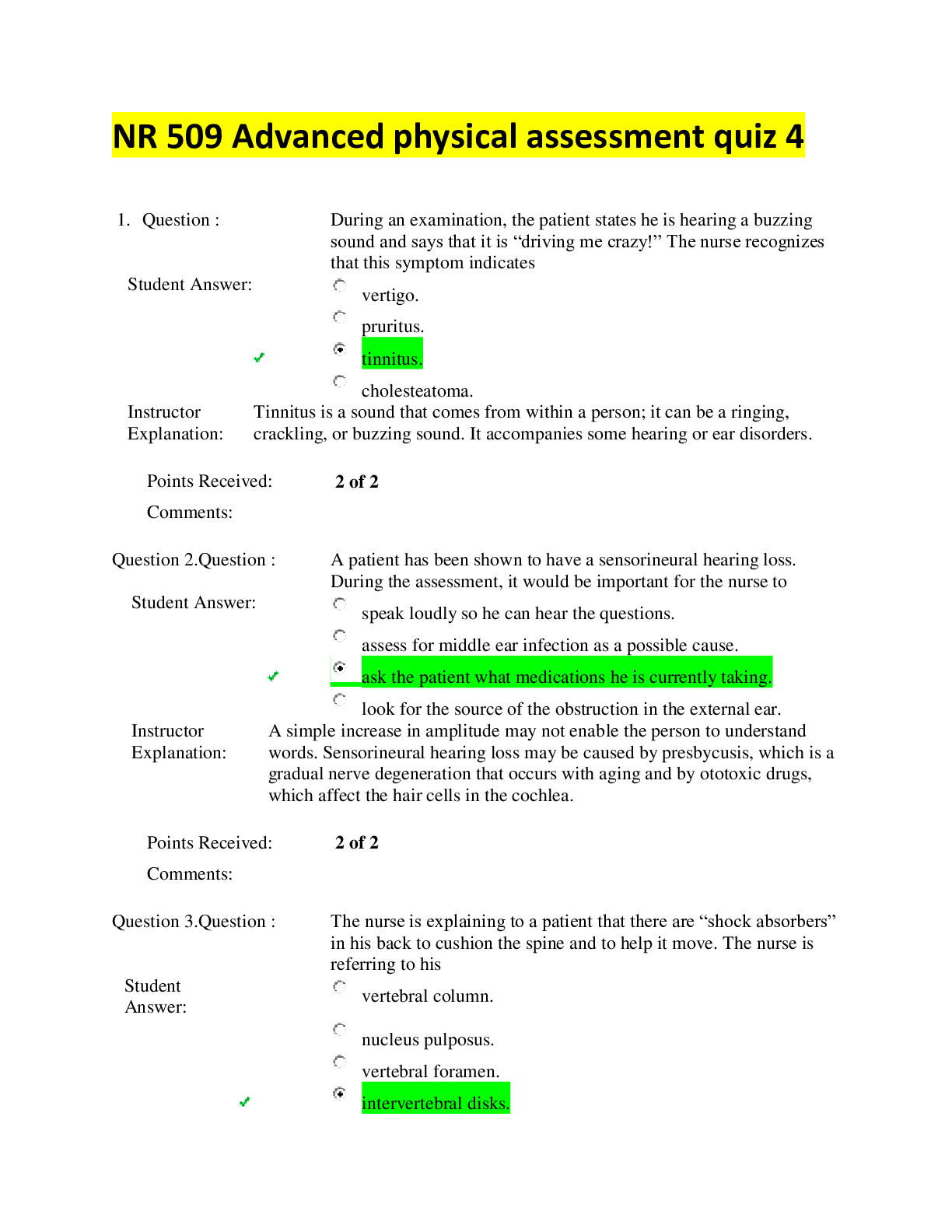
Buy this document to get the full access instantly
Instant Download Access after purchase
Buy NowInstant download
We Accept:

Reviews( 0 )
$13.00
Can't find what you want? Try our AI powered Search
Document information
Connected school, study & course
About the document
Uploaded On
Mar 13, 2020
Number of pages
31
Written in
All
Additional information
This document has been written for:
Uploaded
Mar 13, 2020
Downloads
0
Views
121

